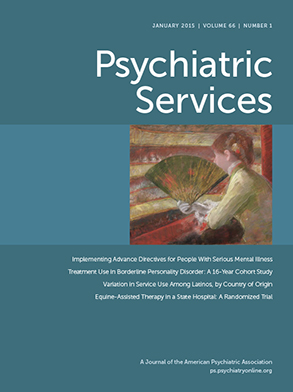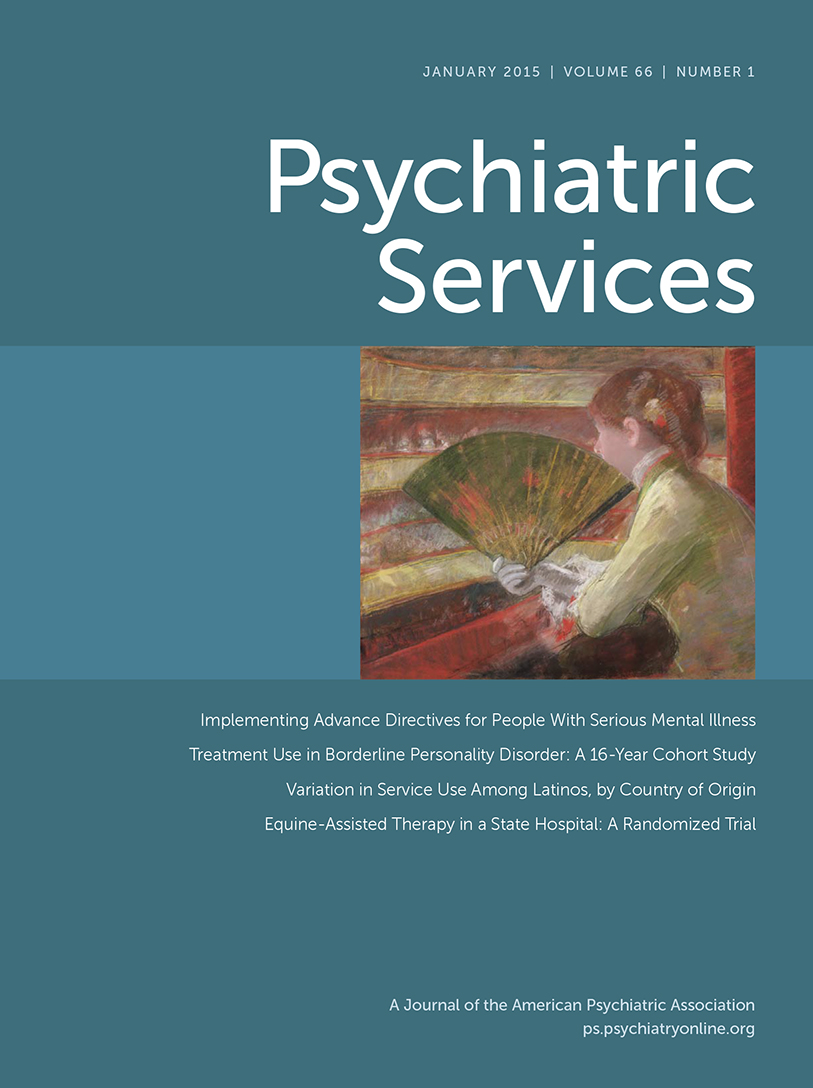Lack of social support is associated with an increased likelihood of developing PTSD after a traumatic event (
5–
9) and with greater severity of PTSD among those with the disorder (
10–
12). However, the collected findings on the relationship between social support and mental health care engagement are equivocal. In some studies, greater levels of social support were associated with greater utilization of mental health services among individuals with PTSD (
13–
17). Social support may increase care utilization because an individual’s support network encourages him or her to seek treatment when it is needed. In this conceptualization, social support acts as an “enabling” factor that facilitates treatment engagement (
18).
In contrast, other studies have reported an inverse relationship between social support and treatment utilization, such that greater levels of social support were associated with reduced utilization of mental health services (
19–
21). Social support may reduce care utilization because the social network serves as an already established helping resource. Social support, therefore, may act as a “buffer” to mitigate the severity of PTSD, thus reducing the need for treatment (
22). Still other studies have failed to find a relationship between social support and treatment utilization (
23,
24) or have found that the direction of the relationship depends on the quality of social support (
4).
Most prior research examining the linkage between social support and treatment utilization has relied on modest sample sizes and has controlled for few, if any, demographic variables. In some cases, the studies lacked sufficient power to control for sociodemographic variables. As a result, treatment utilization patterns that are partially attributable to marital status or socioeconomic status, for example, may be attributed to other factors, such as social support. Another potential weakness of previous studies is their tendency to focus on general mental health treatment rather than PTSD-specific treatment. In addition, previous investigations have rarely examined the influence of social support on different types of PTSD treatment.
In this study, we used a large, nationally representative sample to probe the relationship between social support and PTSD treatment utilization. We hypothesized that interpersonal support would be significantly associated with the likelihood of obtaining several types of PTSD-specific services, even after we controlled for a wide range of sociodemographic factors.
Results
Table 1 presents demographic characteristics of the final sample. Of the 2,811 individuals, 72% were female, 71% were non-Hispanic white, 57% were married or cohabiting, 46% were employed, 88% had health insurance, and 86% had at least one other comorbid psychiatric disorder.
Results from the unadjusted logistic regression models are displayed in
Table 2. Social support was not associated with receipt of any services overall for PTSD nor was it associated with receipt of three out of four specific kinds of PTSD services (outpatient treatment, hospitalization, or emergency department visits). A modest association between social support and PTSD medication use was observed, such that each increase of one unit of social support was associated with a 2% decrease in the odds of receipt of medication for PTSD.
Table 3 depicts results from the adjusted logistic regression models estimating the associations between level of social support and the odds of receiving PTSD services. After adjustment for all sociodemographic variables and PTSD symptom severity, the analyses showed that social support was not associated with the overall odds of receiving any PTSD-related services nor was it associated with receipt of specific types of PTSD services. The following variables were associated with greater odds of receipt of any treatment: female sex; higher educational attainment; greater income; divorced, separated, or widowed status; health insurance coverage; greater levels of psychiatric comorbidity; and greater PTSD symptom severity. Individuals who were older (age ≥65), non-Hispanic black, foreign born, and employed had lower odds of receiving treatment.
To further probe the hypothesized relationship between level of social support and PTSD treatment utilization, we conducted supplementary analyses. For these analyses, following Moak and Agrawal (
33), we categorized the ISEL-12 scores into quartiles of high social support, intermediate-high social support, intermediate-low social support, and low social support. In the first set of supplementary analyses, we tested whether the interaction of ISEL-12 scores and PTSD severity had an effect on treatment utilization. The results indicated that none of the interactions were significantly related to the overall odds of treatment or specific types of PTSD treatment. In the second set of supplementary analyses, we investigated the effects of potential interactions between ISEL-12 results and marital status on utilization of PTSD treatment. The results indicated that the relationship between social support and PTSD treatment utilization did not vary by marital status.
Discussion
In this study, we investigated the hypothesized relationship between perceived social support and the receipt of several types of health care services for PTSD. With the exception of the medication outcome, we failed to detect associations between social support and PTSD-specific treatment utilization. Moreover, after adjustment for sociodemographic variables and symptom severity, there was no significant association between level of social support and the odds of any type of PTSD treatment. Our work extends previous research by utilizing a large, nationally representative sample and by taking into account demographic and illness factors that have previously been found to be associated with treatment utilization.
Previous findings about the relationship between social support and mental health treatment engagement have varied. Several studies supported an inverse relationship between social support and mental health care utilization. For instance, among 154 veterans filing claims for U.S. Department of Veterans Affairs disability benefits for PTSD, those in mental health treatment reported lower social support (
21). In another study, greater readjustment stress (marital and family problems, loss of a loved one, or other indicators of lower social support) was associated with a greater number of mental health visits by National Guard soldiers (
20). In another sample of National Guard soldiers, lower social support after deployment was related to greater psychiatric medication usage but was not related to psychotherapy utilization (
19). That study echoed our unadjusted finding that social support was related to use of psychiatric medication specifically.
Other studies, however, have reported a positive relationship between social support and mental health service utilization. One study found that seeking mental health services was associated with greater levels of social support among women with PTSD (
13). Another study reported that greater spousal involvement was associated with greater engagement in trauma-focused treatment among Vietnam veterans (
14).
In line with our findings, additional research indicates that there is not a significant association between social support and treatment seeking. Pietrzak and colleagues (
23) found that social support after deployment was not related to perceived barriers to care among returning veterans. Another study found that after the analyses controlled for PTSD symptom severity and cumulative trauma exposure, social support was not associated with treatment seeking in a sample of 549 Canadian veterans (
24).
Reasons for the inconsistent findings in the literature remain unclear; however, the conflicting results may be due to variation in study design and sampling (such as studies of small groups of veterans in clinic-based settings versus large, general population-based surveys), measurement of social support, and adjustment for other important factors.
In the analyses in this study, we included several sociodemographic factors that have been found to be related to mental health treatment seeking. Indeed, several of these demographic variables were significantly associated with PTSD treatment utilization. These included age, sex, race-ethnicity, education, income, marital status, and psychiatric comorbidity. These findings are largely consistent with the published literature. For instance, among all individuals with anxiety disorders in the NESARC survey, middle-aged adults were the most likely to have received mental health services in the past year, and older adults were the least likely (
3). These results are consistent with our finding that older adults were less likely than young adults to use PTSD services and that adults age 45–64 were more likely than young adults to use PTSD medications. We also found that women were more likely than men to receive PTSD services. The NESARC data set supported this finding—among all individuals with anxiety disorders, women were more likely than men to have received mental health services in the past year (
3).
Another study from the NESARC data set also supported our finding that blacks were less likely than whites to receive medication for PTSD and also less likely to receive any type of PTSD services. It found that racial-ethnic minority groups (including black, Asian, and Hispanic individuals) were less likely than whites to receive outpatient care for PTSD (
34). In regard to marital status, we found that individuals who were divorced, separated, or widowed were more likely to receive services than individuals who were married. Previous findings on marriage and health service use are mixed (
17), although, consistent with our findings, some investigations have reported greater use of services among divorced or separated individuals (
35,
36). Finally, we found that individuals with three or more comorbid axis I disorders were more likely to use PTSD services compared with persons without a psychiatric comorbidity. Similarly, a previous study found that among all individuals with anxiety disorders in the NESARC data, individuals with comorbid mood and anxiety disorders were more likely than those without such disorders to use services in the past year (
3). Thus sociodemographic characteristics and psychiatric comorbidities may be salient factors in PTSD treatment utilization.
Potential relationships between social support and treatment utilization may also be accounted for by PTSD severity. Symptom severity is a robust and reliable predictor of service utilization (
37–
43) and is also highly correlated with social support (
10–
12,
44). Among National Guard soldiers, greater psychiatric medication usage was related to both reduced postdeployment social support and greater PTSD severity (
19). Furthermore, Meis and colleagues (
17) found that the impact of social support on treatment utilization was fully accounted for by PTSD symptom severity. Although the NESARC did not collect information on symptom severity per se, we included the number of PTSD symptoms as a proxy for severity. Moreover, this variable was robustly related to the odds of receiving all types of PTSD treatment.
Our study had several potential limitations. First, the NESARC survey used retrospective data, potentially reducing the accuracy of recall. Second, the survey was conducted by nonclinician interviewers, which precludes the use of clinical judgment in determining diagnoses. Third, the cross-sectional design prevents any determination of causality. Limitations of our social support measure included the fact that the ISEL-12 assesses only positive aspects of social support and does not address the negative aspects of social relationships or social strains. Furthermore, the ISEL-12 may not specifically address how members of a participant’s social network affect that participant’s health-related problems or service utilization.
Another limitation of our data was that we assessed current levels of social support but assessed PTSD and mental health service utilization over the course of the participant’s lifetime. This study feature may mask potential temporal relationships between social support and help seeking. For example, diminished social support may be a consequence of failing to receive treatment after PTSD onset rather than a contributor to not seeking treatment. Consequently, additional longitudinal data are required to better address such concerns. Finally, the mean ISEL-12 score for the NESARC sample was relatively high. It is possible that results may differ among populations with lower levels of social support.

